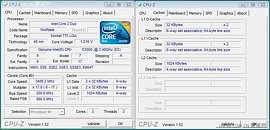Tuesday, August 25th 2009

Intel Plans 3.40 GHz Celeron E3900 for 2010
Although a large chunk of products based on the new sockets LGA-1156 and LGA-1366 arrive in 2010, effectively pushing LGA-775 out of the extreme, performance, and upper mainstream segments, Intel will continue launching new low-end LGA-775 processors in an effort to digest inventories of motherboards and memory compatible to that socket. The company's grassroot processor brand Celeron will be updated with the E3000 series, consisting of dual-core processors based on the Wolfdale-1M core. The 45 nm based core offers the essential features for basic computing, while running cool and priced low.
Two quarters ahead of its expected launch, sources in the Chinese media unearthed Celeron E3900, perhaps the last SKU in the E3000 series. Slated for Q1 2010, the Celeron E3900 runs at 3.40 GHz (200 MHz x 17), with an FSB speed of 800 MHz. It has a shared L2 cache size of 1 MB, and supports the most common instruction sets including SSE3, SSSE3, and x86-64, although SSE4.1 and Intel-VT isn't part of it. The latest company roadmap of the essential and value segments show that the company looks as far as Q3 2010 with its Celeron and Core 2 Duo brand products, with existing number schemes. In essence, retailers in Q3 2010 shouldn't have stock problems selling you these processors.
Source:
INPAI
Two quarters ahead of its expected launch, sources in the Chinese media unearthed Celeron E3900, perhaps the last SKU in the E3000 series. Slated for Q1 2010, the Celeron E3900 runs at 3.40 GHz (200 MHz x 17), with an FSB speed of 800 MHz. It has a shared L2 cache size of 1 MB, and supports the most common instruction sets including SSE3, SSSE3, and x86-64, although SSE4.1 and Intel-VT isn't part of it. The latest company roadmap of the essential and value segments show that the company looks as far as Q3 2010 with its Celeron and Core 2 Duo brand products, with existing number schemes. In essence, retailers in Q3 2010 shouldn't have stock problems selling you these processors.

30 Comments on Intel Plans 3.40 GHz Celeron E3900 for 2010
400*17 = Almost 7 ghz
This should be interesting
LIST:
e8700
e6500k
q7600
e3900
just my two cents.
And getting 800FSB processors up to 1600FSB is pretty easy, I got my E1400 up to 1600FSB pretty easily.
With this thing being 45nm, and having double the L2 of the E1000 series...I really want to play.
its only got 1MB cache, but it will OC like made to make up for it with that multi.
the celeron name doesnt mean what it used to - this is going to be one of those magic chips that overclocks madly.
And in the thread with the quad core version, where was the whiners? oh, they were all busy praising it just because it didnt have the celeron name.
So in this case, although having a low FSB with an extremely high multi means that you can overclock to ridiculous numbers (you can break the 4.0GHz barrier with just a 40MHz increase!), it may actually give less real world performance-per-clock-cycle than a CPU with a high FSB and low multi, like the E8x00 series.
You know, I wonder how this thing would perform if you dropped the multi to x12 and increased the FSB? Normally I don't like that form of overclocking because it puts more strain on the motherboard and increases instability. However, if this CPU is capable of such high clock speeds then there's no sense wasting them twiddling its thumbs waiting for instructions. A multi of x12 and FSB of 375 (1500... high, but manageable on high end boards) would give you a clock speed of 4500MHz. I expect that would be the most performance you could get out of this chip, and it's a lot of performance! Again, though, there's the issue of instability, and the bus wall. I don't know. Maybe a compromise? Multi = x14, FSB= 300MHz?
But though this is obviously appealing to overclockers who care more about clock speed than real performance, I think the real reason Intel has gone with this combination of low FSB and high multi is because it gives them the ability to put a processor with a very, very high clock speed onto very low-end motherboards that don't support the higher bus speed needed for CPUs like the E7x00 and E8x00 processors. Thus I expect to see a lot of these in 2010/11's OEM machines.
Its kinda like a Pagani Zonda with Wal-Mart all season tires on it!
EDIT: MN12BIRD: nice c64 dealy
lowering the multi to find the sweet spot between CPU and ram is standard OCing practice. You'd assume people would do that, yes.
Intel is giving this CPU a deceivingly high clock speed, so they can get idiots thinking that because the number before "GHz" is bigger that this CPU is better than, say, an E8600. The x17 multi is a gimmick, and the only people it should excite are overclockers who don't realize that clock speed isn't always the prime factor in determining performance.
EDIT:
Gave you a thanks to let you know I'm not trying to sound like a douche or insult in anyway. :)
Phædrus: show me anything - anything, with reliable testing that has a speed difference, with the only change being the multiplier. same CPU frequency, same ram frequency, same HT link if on AMD.
I've seen people prove time and again that cache makes a difference (if not in every application) but in all the years i've been using PC's - back when multipliers were first introduced i have never, EVER seen ANY evidence that higher multis cause poor performance.
look how fast my rig is, its amazing..... yeah sure oh but its got a celeron inside NO THANKS
Just call it by its E number